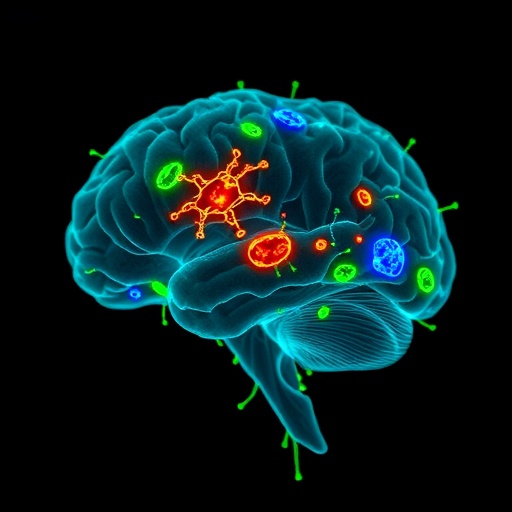In a groundbreaking advancement that could redefine the treatment landscape for devastating neurodegenerative and lysosomal storage diseases, researchers have unveiled a novel therapeutic approach targeting microglial cells within the brain. This innovative strategy leverages the transplantation of allogeneic myeloid cells directly into the brain, bypassing the need for systemic hematopoietic stem cell transplantation (HCT) and its accompanying risks. The study, led by Mader et al., challenges long-held paradigms in neuroimmunology and stem cell biology, setting the stage for safer, more effective brain-targeted therapies.
Conventional approaches to allogeneic HCT involve a high degree of myeloablation—a process in which the patient’s bone marrow is extensively destroyed to make room for donor cells. While essential for peripheral engraftment, this toxic conditioning leads to severe, sometimes fatal side effects, thereby limiting the clinical applicability of HCT. This is particularly problematic in the context of neurological diseases, where hematopoietic stem cells must infiltrate an immune-privileged organ protected by the blood-brain barrier. Even when successful, transplanted myeloid cells remain vulnerable to immune rejection once inside the brain, diminishing therapeutic outcomes.
Addressing these challenges, the researchers developed a brain-restricted technique that achieves efficient microglial replacement without systemic myeloablation. Contrary to the conventional wisdom that hematopoietic stem cells are necessary to reconstitute brain myeloid populations, the study reveals that committed Sca1-negative progenitor cells suffice to repopulate the microglial niche robustly following intracerebral injection. This discovery not only contradicts earlier assumptions but also opens new avenues for targeted therapies avoiding the systemic complications of conventional transplantation.
The methodology employed involves delivering these Sca1-negative progenitor cells directly into the brain following localized conditioning that selectively depletes resident microglia. By circumventing the need for systemic preconditioning, the authors eliminated the potential for prolonged peripheral engraftment, which often leads to graft-versus-host disease and other adverse immune responses. This localized approach ensures that therapeutic cells reside predominantly within the brain, thereby minimizing systemic immune interactions that compromise transplant efficacy.
The pathological focus of this therapeutic platform is particularly promising for lysosomal storage diseases, such as Sandhoff disease—a fatal neurodegenerative disorder characterized by the accumulation of GM2 gangliosides due to deficiencies in the enzyme hexosaminidase B. Using a murine model, the authors demonstrated remarkable reversal of disease phenotypes following intracerebral transplantation of donor-derived myeloid progenitor cells. Microglial replacement resulted in restoration of lysosomal enzyme activity, reduction of pathological substrate accumulation, and improved neurological function, highlighting the clinical potential of this strategy.
Moreover, the translational relevance of these findings is emphasized by their extension to human cells. Induced pluripotent stem cell (iPSC)-derived myeloid progenitors mirrored the engraftment efficiency observed in murine models when subjected to brain-restricted conditioning protocols. This cross-species validation supports the feasibility of adapting this technique to human patients, heralding a new era of personalized cellular therapies for neurodegenerative and lysosomal storage diseases.
This focus on microglia—the brain’s resident immune cells—is particularly significant given their multifaceted roles in maintaining neural homeostasis, modulating inflammation, and clearing cellular debris. By replacing dysfunctional microglia with healthy, genetically corrected counterparts, this approach not only addresses the enzymatic deficits but also restores the immunological milieu of the brain, which is critical for halting or reversing disease progression.
Importantly, this work challenges the previous assumption that the brain microenvironment requires input from systemic hematopoietic stem cells for myeloid replacement. Instead, the identification of unipotent progenitor cells capable of colonizing and self-renewing within the brain microglial niche provides a more targeted and efficient strategy. This refined understanding recalibrates how scientists perceive microglial ontogeny and plasticity in adult brains, potentially impacting a broad range of neuroimmunological research.
Beyond the immediate therapeutic applications, the novel preconditioning strategy devised here serves as a paradigm shift in transplantation biology. By restricting conditioning to the brain, it markedly reduces systemic toxicity and immune complications, potentially expanding eligibility for stem cell-based therapies to patient populations previously deemed too fragile for aggressive ablation protocols. This could fundamentally change clinical guidelines surrounding transplantation in neurodegenerative contexts.
The implications for gene therapy are also profound. Since allogeneic myeloid cells can be genetically engineered prior to transplantation, the ability to replace diseased microglia at high efficiency within the brain opens new paths for correcting genetic defects in situ. Importantly, the localized delivery and engraftment approach increase therapeutic effectiveness while mitigating off-target effects and systemic immune responses that have hindered gene therapy’s broader application.
Future research will likely focus on refining progenitor cell isolation and expansion techniques, optimizing intracerebral delivery methods, and establishing long-term safety and efficacy in larger animal models and human trials. Additionally, understanding the molecular mechanisms underpinning successful microglial engraftment and niche saturation will be critical to further enhancing the durability of therapeutic effects and preventing immune escape or rejection.
Ultimately, this study by Mader and colleagues not only overcomes the critical barriers limiting conventional HCT in neurological diseases but also offers a scalable framework for allogeneic brain microglial replacement therapies. Its innovative blend of immune privilege exploitation, cellular specificity, and genetic correction has the potential to revolutionize treatment paradigms for numerous currently incurable brain disorders, bringing hope to millions worldwide.
As neurodegenerative diseases continue to rise in prevalence and therapeutic options remain limited, the promise of safe, efficient, and targeted microglial replacement marks a monumental leap forward. This cutting-edge approach underscores the importance of integrating stem cell biology, immunology, and neuroscience to achieve transformative therapeutic breakthroughs. The clinical translation of this technology could herald a new future where genetic brain disorders are not only manageable but possibly curable.
Subject of Research:
Therapeutic genetic restoration via allogeneic brain microglia replacement targeting lysosomal storage diseases and neurodegeneration.
Article Title:
Therapeutic genetic restoration through allogeneic brain microglia replacement.
Article References:
Mader, M.MD., Scavetti, A., Yoo, Y. et al. Therapeutic genetic restoration through allogeneic brain microglia replacement. Nature (2025). https://doi.org/10.1038/s41586-025-09461-6
Image Credits: AI Generated




